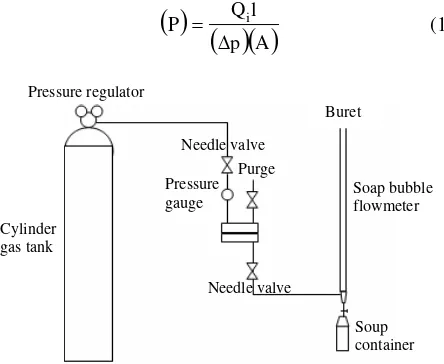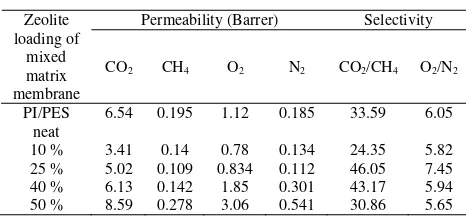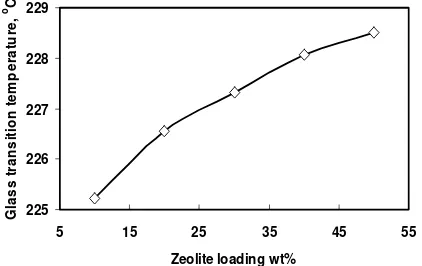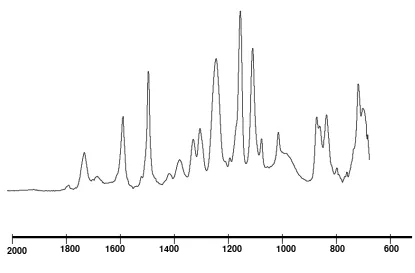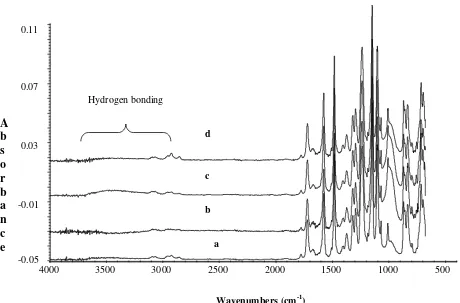THE EFFECT OF TYPE ZEOLITE ON THE GAS TRANSPORT
PROPERTIES OF POLYIMIDE-BASED
MIXED MATRIX MEMBRANES
Tutuk Djoko Kusworo
1*), Ahmad Fauzi Ismail
2), Azeman Mustafa
2), and Kang Li
2,3) 1)Department of Chemical Engineering,Faculty of Engineering, University of Diponegoro
Jl. Prof. Soedarto, SH, Tembalang, Semarang Indonesia, Telp/Fax: +62-24-7460058 ; +62-24-76480675
*)Corresponding author: tutukjoko@yahoo.com
2)Advanced Membrane Technology Research Centre (AMTEC),
Faculty of Chemical and Natural Resources Engineering,
Universiti Teknologi Malaysia, 81310 UTM, Skudai, Johor Bahru, Malaysia
3) Department of Chemical Engineering and Chemical Technology,
Imperial College London
Abstract
The permeation rates of O2, N2, CO2 and CH4 has been studied for polyimide-polyethersulfone
(PI/PES) blends-zeolite mixed matrix membranes synthesized in our laboratory. The study investigated the effect of zeolite loading and different zeolite type on the gas separation performance of these mixed matrix membranes. Frequency shifts and absorption intensity changes in the FTIR spectra of the PI/PES blends as compared with those of the pure polymers indicate that there is a mixing of polymer blends at the molecular level. Differential scanning calorimetry measurements of pure and PI/PES blends membranes have showed one unique glass transition temperature that supports the miscible character of the PI/PES mixture. The PI/PES-zeolite 4A mixed matrix membrane with 25 wt % zeolite loading produced the highest O2/N2 and CO2/CH4 selectivity of around 7.45 and 46.05, respectively.
Keywords:gas separation membrane, mixed matrix membrane, polymer blending, zeolite membrane
Abstrak
Kecepatan permeasi dari gas-gas O2, N2, CO2 dan CH4 pada kombinasi poliimda dan poliethersufon
(PI-PES) matrik campuran membran telah dikaji di dalam laboratorium. Penelitian ini dilakukan untuk mengetahui pengaruh muatan dan jenis zeolite pada kinerja matrik campuran membran tersebut. Pada analisa dengan menggunakan FTIR didapatkan bahwa pencampuran polimer poliimida dan poliethersulfon telah berlangsung pada tingkat molecular. Pada analisa lebih lanjut dengan menggunakan DSC didapatkan bahwa kombinasi PI/PES menghasilkan satu suhu glass tansisi yang menunjukan bahwa kedua polimer dapat bercampur dengan sempurna. Matrik campuran membrane PI/PES-zeolite dengan muatan zeolite sebesar 25% menunjukan kinerja yang bagus dengan menghasilkan selektivitas untuk O2/N2 dan CO2/CH4 adalah sebesar 7,45 dan 46,05.
Kata kunci:pemisahan gas, campuran polimer, matrik campuran membrane, zeolite membran
INTRODUCTION
Currently, membrane remains offering a wide range of applications for many gas separation industries such as natural gas processing, landfill gas recovery, air separation and hydrogen recovery (Kim et al, 2004). It
is well known that the glassy polymer membranes perform well in separations of mixtures of gases such as O2/N2, H2/CO, and N2/CO2. However, there are
challenges in preparing membranes with improved anti-plasticization and desirable combination of both high
and the selectivity (Jiang et al, 2006). Meanwhile, the
rigid porous materials such as carbon molecular sieves and zeolites are poor in process ability and difficulties in forming defect-free membranes for practical applications in spite of their superior gas separation properties. To overcome the drawbacks of both polymeric and molecular sieve materials, mixed matrix membranes have been extensively examined for gas separation during the past two decades. The materials are fabricated by encapsulating the molecular sieves into the polymer matrix. Mixed matrix membranes have been recognized as a promising alternative to the conventional membranes.
Kulprathipanja and co workers observed that the O2/N2 selectivity increased from 3.0 to 4.3 when
increasing silicalite content in the cellulose acetate matrix (Li et al, 2005). It has been found that when
using rubbery polymers as the membrane matrix, the contact between the polymer matrix and the molecular sieve is satisfactory owing to the highly flexible polymer chain. According to Jia et al (1991), the
incorporation of silicalite into silicone rubber (PDMS) membranes increased the O2/N2 selectivities from 2.14
to 2.92 in comparison to pure PDMS. Duval et al (1993)
studied carbon molecular sieve and zeolite such as silicalite-1, 13 X and KY as filler. They observed that membrane with the filler such as silicalite, 13 X and KY could increase the selectivity by 13.5% to 35%, respectively. They also concluded that molecular sieve did not improve the separation performance of mixed matrix membrane.
Currently, the research focuses more on the glassy polymers (Duval et al, 1993). However, the
major problem of mixed matrix membranes using glassy polymers is adhesion between the polymer phase and the external surface of the particle. It seems that the weak polymer-filler interaction makes the filler tend to form voids in the interface between the polymer and filler. Therefore, the resultant membranes generally have deteriorated selectivity. Various methods have been proposed to improve the polymer-filler contact. Duval et al (1994) proposed fabrication of mixed matrix
membrane at above glass transition temperature, while Rojey et al (1990) incorporated zeolite 4A in the Ultem
matrix to significantly enhance the H2/CH4 selectivity.
Süer et al (1994) reported significant increase in the
separation performance of mixed matrix membranes made of polyethersulfone and zeolite 13 X and 4A. They found that both gas permeabilities and selectivities of N2, O2, Ar, CO2, and H2 increased with an increase in
zeolite loadings. A large amount of zeolite induced the formation of micro porous cavities and channelling, thus demonstrating the weak interactions and incompatibility of these materials. Some studies have suggested selection criteria for materials and preparation protocols in order to meet the transport characteristics necessary to form high separation performance of mixed matrix membrane (Vankelecom
et al, 1996; Zimmerman et al, 1997; Mahajan and
Koros, 2000). Vu et al (2003) incorporated CMS into
commercial glassy polymers, Ultem and Matrimide 5218. They reported that mixed matrix membranes with these CMS particles showed enhancement by up to 40-45% in CO2/CH4 selectivity over the intrinsic
selectivity of the pure Ultem and Matrimide polymer. Currently, polymer blends have emerged as one of the most efficient means of obtaining new materials having improved mechanical properties. Hence, polymer blends offer an attractive option to get the same enhanced properties in a more economical and simpler manner. Therefore, the present paper studies an alternative preparation of mixed matrix membrane using polyimide and polyethersulfone blends for O2/N2 and CO2/CH4
separation with different type of zeolite such as 4A, 5A and 13 X as inorganic filler. The paper was also investigated the effect of zeolite loading on the performance of mixed matrix membrane. The zeolite was incorporated into blended polyimide/polyethersulfone matrices. Polymer blend was made since the blended polymer can show new properties not found in any individual polymer. Furthermore, the blending is an alternative way of reducing the price of membranes.
EXPERIMENTAL METHOD Material
Polyimide (Matrimide 5218) resin was supplied by Alfa Aesar Johnson Mattew Mexico and polyethersulfone by Solvay Advanced Material (USA). The polymers were dried in a vacuum oven at 120oC overnight before dope preparation;
N-methyl-pyrrolidinone (NMP) from Merck was used as the solvent due to its low toxicity. The inorganic filler molecular sieve involved was zeolite 4A, 5A and 13X purchased from Aldrich and the particle size was less than 1 µm. In order to remove the adsorbed water vapour or other organic vapours, all zeolite particles were dehydrated at 300oC for 3 h before use.
Fabrication of Symmetric Flat Sheet Mixed Matrix Membrane
In this study, the polymer solution consists of 25 wt % polymer (blend PI/PES, 20/80), and 75% NMP + 10-50 wt % zeolite loading in total solid. The casting dope was prepared according to the following procedure: The inorganic molecular sieve particles were dispersed into the solvent and stirred for 24 hours, followed by the addition of a desired amount of polyimide. The suspension was then agitated with a stirrer for at least 24 hours to ensure complete dissolution of the polymer. Next, a desired amount of polyethersulfone was then added and was further agitated at high speed for at least 2 days. Before casting, the prepared suspension was degassed under vacuums for 3 hours. The flat sheet symmetric membrane was prepared according to the technique proposed in (Li et al, 2005; Mahajan et al, 2002),
voids. The suspension was poured onto a clear, flat and smooth glass plate placed on a trolley. Stainless steel support casting knife was used to spread the solution to a uniform thickness by using a pneumatic force.
Characterization of Mixed Matrix Membrane
A Supra 35 VP Field Emission Scanning Electron Microscopy (FESEM) was used to investigate the asymmetric structure of the membranes. Membrane samples were fractured in liquid nitrogen. The membranes were mounted on an aluminium disk with a double surface tape and then the sample holder was placed and evacuated in a sputter-coater with gold.
The changes in the chemical structure caused by polymer blending were identified using Fourier transform infrared spectroscopy (FTIR). The IR absorption spectra were obtained at room temperature in a range from 4000 to 500 cm-1 with a spectral resolution
of 8 cm-1 and averaged over 16 scans.
The glass transition temperature of each cast film was determined using differential scanning calorimetry (Mettler Toledo DSC 822e). A small piece of membrane or pure polymer sample was first stored under vacuum at 100oC for 24 hours to remove
adsorbed water; then weighed and placed into aluminium DSC pans. The temperature scanning range was 50- 320oC with scanning rate of 10oC min-1 in the
first DSC cycle to remove thermal history and then cooled from 320 to 25oC at the rate of 10oC min-1;
finally the second cycle was carried out with the same procedure.
The permeation test involved the use of gas permeation cell in which the membrane was placed on a sintered metal plate and pressurized at the feed side. Gas permeation rates were measured by a constant pressure system using a soap bubble flow meter. Figure 1 illustrates the gas permeation cell set up.
The permeability of the gas can be calculated as follows:
Figure 1. (a) Flat sheet membrane gas permeation measurement set up
Figure 1. (b) Gas permeation test cell
where Qi is the volumetric flow rate of gas “i” at
standard temperature and pressure, ∆p is the trans
membrane pressure difference, l is the membrane thickness and A is the effective membrane area. Permeability is expressed in barriers (1010 cm3 (STP)
cm/cm2 s cm Hg). The ideal separation factor
can be calculated by using equation below:
j
RESULTS AND DISCUSSION
Morphology of Mixed Matrix Membranes
The FESEM analyses were performed in order to investigate the effect of zeolite loading and type of zeolite on the morphology of mixed matrix membrane. The cross-sectional and top surface FESEM images of the PI-PES blend-zeolite mixed matrix membrane are presented in Figures 2-3. The effect of zeolite loading on the morphology of the mixed matrix membranes is depicted in Figure 2. Higher loadings of zeolite in the mixed matrix membranes resulted in more brittle membranes. A 25 wt % zeolite loading in the mixed matrix membrane did not show sedimentation or agglomeration of zeolite particles (Figure 2a). Increasing zeolite loading up to 40% produced slight agglomeration of zeolite particles as shown in Figure 2b. In addition, the mixed matrix membrane was seemed to be phase-separated and forming a non-uniform composite membrane. Increasing zeolite loading up to 50 wt % caused severe agglomeration of zeolite particles forming large clusters (Figure 2c). Furthermore, the agglomeration of zeolites caused pinholes as non-selective defects. This level of zeolite loading also generated a significant stress to the rigid PI and PES chains, resulting in fragile membranes.
Figure 2. Cross-section images of PI/PES blends-zeolites 4A mixed matrix membranes with different
loading a: 25 wt %, b: 40 wt % and c: 50 wt % The FESEM images for the cross-sectional morphology of PI/PES mixed matrix membranes dispersed with 25 wt % zeolite 4A, 5A and 13X are shown in Figure 3(a)-(c). Annealing process of all the mixed matrix membranes was prepared above the Tg of
the 20/80 PI/PES blend polymer. Generally, after annealing above the Tg, the structure of all different
pore sizes of zeolite was similar; i.e. a homogeneous distribution of zeolite in the matrix. At this stage, the zeolite 4A and 13 were observed to be better well-dispersed than zeolite 5A. The continuous channel network in the polymer matrix also was apparently formed in these membranes. Zeolite 4A is the sodium form of the type A crystal structure with 22.99 atomic
weight, whereas zeolite 5A is the calcium form with 40.08 atomic weight, respectively. Therefore, the zeolite 5A which is greater than zeolite 4A may caused it to precipitate in the polymer matrix during the membrane fabrication. Meanwhile, mixed matrix membrane made from PI/PES polymer incorporation with lighter zeolite 4A could have been dispersed more uniformly.
a
Zeolite particle
Zeolite particle
Zeolite
particle
Figure 3. Cross-section images of PI/PES mixed matrix membrane with zeolite 4A, 5A and 13X c
b
b
a
Better adhesion of polymer-sieve particles
c
Koros et al (1997) and Kim et al (2006)
suggested that the high gas separation performance of mixed matrix membranes can be reached due to continuous pathways in the morphology of mixed matrix membrane. However, in this case as shown in Table 1, the separation performance of PI/PES-zeolite 5A mixed matrix membrane in term of selectivity is higher than PI/PES-zeolite 13X. This phenomenon indicates that zeolites type also play an important role in determining the gas separation performance of the mixed matrix membrane. Moreover, the gas transport through the mixed matrix membrane is affected by the properties of zeolites such as the composition of zeolite, pore size and pore structure. The effect of zeolites pore size and composition on the gas separation performance of the mixed matrix membrane will be discussed in detailed in the next section.
Table 1. The effect of different pore size on gas separation performance of membrane
Single gas permeance (barrer) Selectivity Membrane
Effect of Zeolite Pore Size on Gas Separation Performance
In order to study the effect of pore size of zeolites on the gas separation performance, the permeance of PI/PES-zeolite 4A, PI/PES-zeolite 5A and PI/PES-zeolite 13X membranes were investigated. The characteristic of zeolites used in this experiment are presented in Table 2.
Table 2. Characteristic of zeolites
Zeolite Structural
Zeolite molecular sieves are crystalline, highly porous materials, which belong to the class of micro porous aluminosilicates containing pores equivalent to the diameters of some molecules. Single-gas permeation rates were measured at 35oC and 10 bars for O
2, N2 CO2
and CH4. As discussed in above section, the adhesion of
polymer matrix and zeolite particles obtained for the PI/PES 20/80 incorporated with 25 wt % zeolite is better than that of other compositions. Therefore, further study for the effect of different pore size of zeolite on gas separation performance has been done using the optimum polymer solution composition (PI/PES 20/80 and 25 wt % zeolite in the total solid). The effect of different pore size of zeolite in the PI/PES
mixed matrix membranes on the gas separation performance is presented in Table 1. Table 1 show that PI/PES-zeolite 4A mixed matrix membrane posses better separation characteristics than PI/PES-zeolite 13X. PI/PES-PI/PES-zeolite 4A mixed matrix membranes exhibited lower permeability and higher selectivity than pure PI/PES membrane did. This result indicated that unselective void or interfacial void between zeolite particle and polymer in the all of PI/PES mixed matrix membranes were apparently not formed and this was supported by FESEM micrographs in Figure 3(a)-(c). Again, the permeability reduction phenomenon indicated the important role of zeolite pore size in gas transport properties of mixed matrix membrane. The properties of zeolite 4A having open crystal structure and relatively small pore size could induced a resistant to the diffusion of the gas penetrant through the zeolite pore. Moreover, due to its small pore size, zeolite can discriminate gas penetrant on the basis of the differences in molecular size and shape. Previous studies by Süer et al (1994) and Huang et al (2006)
also observed the permeability decompression phenomenon in gas separation performance using mixed matrix membrane. However, in this case, PI/PES-zeolite 13X mixed matrix membrane showed higher permeabilities for all gas studied. For instance, the CO2 permeability of PI/PES-zeolite 13X
exhibited 2.8 times higher than those using PI/PES-zeolite 4A and 2.3 times higher than pure PI/PES membrane respectively. A simple explanation for this phenomenon might be due to zeolite 13X pore size. The pore size of zeolite 13X is 8 Å while the kinetic diameter of gas molecules used in this study is in the range 3.3Å for CO2 and 3.8 Å for CH4, therefore gas
molecules can be easily transported through zeolite. In case of PI/PES-zeolite 4A membrane, lower permeability is achieved compared to pure PI/PES membrane. Again, this result indicates that the pore entrance of zeolite 4A was so small that it can hinder the transport of gas molecules.
The facilitation ratio can be used as a tool to evaluate the effect of zeolite filling on the gas transport properties of mixed matrix membrane. The comparison of facilitation ratio for PI/PES-zeolite 4A, 5A and PI/PES-zeolite 13X mixed matrix membranes are presented in Table 3. According to Jia
et al (1991), the facilitation ratio is the difference in
ratio for CH4 is -0.44. This means that the gas
molecules are difficult to pass through the pores of zeolite 4A. This phenomenon suggested that when the kinetic diameter of the gas molecules penetrant was close to the pore size of zeolites, the molecular sieving effect of zeolite would be taken place. The same observation was also made by Yong et al (2001) when
zeolite 4A was dispersed into polyimide matrix.
Table 3. Facilitation ratio of measured gases for PI/PES-zeolite 4A, PI/PES-zeolite 5A and PI/PES-zeolite 13X
Effect of Zeolite Loading on the Gas Separation Performance of Mixed Matrix Membranes
The effects of zeolite loading on the morphology and performance of mixed matrix membrane are presented in Figure 2 and Table 4, respectively.
Table 4. Effect of zeolite loading on the gas separation performance of 25 wt % PI/PES (20/80) mixed matrix membrane
Permeability (Barrer) Selectivity Zeolite
From the Table 4, it can be observed that the permeabilities of CO2, CH4, O2 and N2 decreased up to
a loading of 25 wt % of zeolite 4A. Above these loading, a recovery in permeabilities started to occur. However, only moderate decrease in of O2/N2 and
CO2/CH4 selectivities was observed. The increasing of
permeability and slightly decrease of selectivity indicates that the PI/PES-zeolite mixed matrix membranes can be potentially used as a material membrane for commercial gas separation application. As presented in Table 4, the trend of permeability of PI/PES mixed matrix membrane as a function of zeolite loading was similar for all of the gases studied. It indicated a similar permeation mechanism for all of the membranes. The increase in permeability with increasing zeolite loading in the polymer matrix might be due to the disruption of polymer chain packing in the presence of zeolite particle which could increase the
free volume available for molecular transport. The unselective voids in the interface of zeolite particle and polymer matrix might be formed due to high zeolite loading in mixed matrix membrane. Thus, the resistance to flow through zeolite particles were significantly reduced. The FESEM in Figure 2c supported that not all zeolite particles were well-distributed through the matrix and some of the zeolite particles formed small domains when the zeolite loading is as high as 50 wt %. Therefore, the zeolite loading was limited to equal or below 40 wt % for the gas permeation test. From Table 4, it can be concluded that the optimum loading was 25 wt % where both permeability and selectivity highest values.
Characterization of Mixed Matrix Membrane by DSC and FTIR
According to Kapantaidakis et al (1996), the
compatibility of miscible polymer blend mixtures can be observed by optical, morphology and thermodynamic measurement. Based on visible investigation, the PI/PES blend in the dope showed no phase separation during the stirring process and the resulting mixed matrix membrane was apparently optical clarity. This result indicated that polyethersulfone and polyimide could make a good miscible polymer. Moreover, the DSC analysis was performed to confirm the miscibility of the blend. The glass transition temperature of the homo-polymers, their blends and the Fox model are provided in Figure 4.
Figure 4. The effect of polyimide weight content on the glass transition temperature of PI/PES
blends-mixed matrix membrane and comparison with polymer mixing theory equation
The Tg for each membrane was determined
from the heat flow versus temperature curve using an onset method. The presence of single Tg indicated
that the PI-PES blends were indeed miscible. Generally, the Tg’s of the miscible polymer blends
can be correlated to the linear relationships with the blend composition by using either the Fox equation (1/Tg =x1/Tg1+x2/Tg2) or by the parallel model (Tg =
x1Tg1+x2Tg2), where Tg is blend glass transition
temperature and x1, x2 are the respective weight fraction
of polymer 1 and 2 in the blend (Kapantaidakis et al,
1996; Kim et al, 2006).
Table 6. Frequency and intensity and assignment of the relevance IR bands in the area 2000-400 cm-1
Bands (cm-1)Intensity PI/PES 1484.5 vs 1482.3 s Aromatic
1235 s 1230 s Asymmetric
SO3
1070 s 1066 w Symmetric
SO3
Figure 6 shows the FTIR spectroscopy for PES, PI and PI/PES-zeolite 4A membranes. The sulfonate groups of PES give characteristic peaks at 1297cm-1 while antisymmetric C-O stretching
frequencies occur at 1235 and 1070cm-1. The
carbonyl groups of polyimide give a characteristic peak at 1780 cm-1 (C=O asymmetric stretch) and 1720 cm-1 (C=O symmetric stretch), while the C-N
primary and secondary vibration give peaks at 1250-1350cm-1. At 2958 cm-1, symmetric stretch of C-H
can be observed. Vibrations of amide group and imide groups can be detected at 1618.5cm-1 and
1370.7 cm-1, respectively. For miscible blend
polymers, the frequency shifts usually indicate specific interactions between the characteristics groups of pure polymers. The strongest frequency shift about 12 and 11 cm-1 was observed for the
polyimide carbonyl group from 1780 to 1769 cm-1,
and 1720 to 1712 cm-1, respectively. Meanwhile,
secondary shift 9 cm-1 was observed for the C-O
bending vibration frequency from 723 to 714 cm-1,
the C-N stretching mode from 1375 to 1372 cm-1 and
the secondary C-N stretching mode from 1247 to 1233 cm-1. Changes in the absorption frequency were
also observed for the polyethersulfone; i.e. stretching aromatic carbon group 1485 to 1482 cm-1 and
asymmetric SO3 from 1235 to 1230 cm-1. To verify
the existence of any interaction and to identify the level of their mixing compatibility between these two polymers, subtraction of PES-zeolite and PI-zeolite from PI/PES-zeolite spectrum was employed. Figure 7 presents the subtracted spectra and the observed frequency shifts and absorption intensity changes for the characteristic groups of the pure polymers. Figure 5. The effect of zeolite loading on the glass
transition temperature of PI/PES blends-mixed matrix membrane
As depicted in Figure 5, the Tg of the mixed
matrix membrane increase to about 1.5-3 oC due to the
incorporation of the zeolite particles. This result is in agreement with previous study done by Nunes et al
(1999). They reported that the Tg of polyetherimide
increased due to the dispersion of nanosized silica particles. This phenomenon indicates that the presence of inorganic filler can affects the mechanical properties of continuous phase as suggested in the previous study (Vu et al, 2003). The increase of Tgmight be due to the
zeolite restrictions to the movement of the polymer chains by the formation of hydrogen bonding between the zeolite particles and polymer. However, Li et al
(2005) observed that the main factors affecting the Tg to
increase with an increase of zeolite loading is due to a fair interfacial interaction between polymer and zeolite
To understand the nature of the interaction of miscible polymer blending and interaction between zeolite particles and polymer matrix, the attenuated total reflectance Fourier transform infrared (ATR-FTIR) was performed for a pure polyimide, polyethersulfone and PI/PES-zeolite mixed matrix membrane. Reflection i.r. bands of typical PI-zeolite, PES-zeolite and PI/PES-zeolite mixed matrix membranes are presented in Tables 5 and 6.
Table 5. Frequency and intensity and assignment of the relevan IR bands in the area 2000-400 cm-1
Figure 8 represents FTIR spectra profile of PI/PES-zeolite 4A with different zeolite loading respectively. The strong new peak in the region of 970 cm-1 to 1012 cm-1 was observed for the
asymmetric stretching of Si/Al-O bonding in zeolite particles. At the region of 3100 cm-1 to 3500 cm-1 the
hydrogen bonding was observed. These peaks shifting appears in these region was due to the stretching and bending of the molecular chain of this membrane.
PI-Zeolite Absorption Bands (cm-1)
A b s o r b a n c
Figure 6. FTIR spectra of (a) PI/PES-zeolite 4A mixed matrix membrane, (b) neat of PI membrane and (c) neat PES membrane.
Figure 7. FTIR of substrate and PI/PES blends-Zeolite from PES-Zeolite, PI-Zeolite mixed matrix membrane 0.03
0.06 .09 2 .14 0
0.1
0
Wavenumbers (cm-1)
-0.00
c
b
a
500 1000
1500 2000
2500 3000
3500 4000
Hydrogen bonding
e
0.11
Figure 8. FTIR spectra of PI/PES-zeolite 4A with different zeolite loading (a) 10 wt %, (b) 20 wt % (c) 25 wt % (d) 40 %
The O-H or hydrogen bonding might be formed due to interaction between polymer matrix and zeolite. From the Figure 8, it can be observed that the absorbance intensity of both asymmetric of Si/Al-O and hydrogen bonding in these regions increased up to a loading of 25 wt % of zeolite. Meanwhile, above these loading or at 40 wt % the intensity of peak was decreased. This phenomenon indicated that the stronger interaction between zeolite particles with polymer matrix occur at the 25 wt % of zeolite loading. Generally, the strong interaction could eliminate the voids between the polymer and zeolite. As discussed in section 3.3, the permeability decompression was also occurred at the 25 wt % zeolite loading. While at 40 wt % loading of zeolite, the permeability started to increase. The increasing permeability might be due to the small voids apparently formed in this zeolite loading.
CONCLUSION
The conclusions can be drawn from the present work. The different type of zeolite was affected to determine the gas separation performance of fabrication of zeolite mixed matrix membrane. The PI/PES-zeolite 4A with 25 wt % PI/PES-zeolite loading together with the 25 wt % polymer concentration showed the best performance in terms of gas permeability and selectivity for O2/N2 and CO2/CH4 gas pairs.
REFERENCE
Belfer, S., Fainchtain, R., Purinson, Y., and Kedem, O., (2000), Surface characterization by FTIR-ATR spectroscopy of polyethersulfone membrane-unmodified, modified and protein fouled, J. Membr. Sci., 172, 113-124.
Duval, J.M., Folkers, B., Mulder, M.H.V., Desgrandchamps, G., and Smolders, C.A., (1993), Adsorbent-filled membranes for gas separation. Part 1. Improvement of the gas separation properties of polymeric membranes by incorporation of microporous adsorbents, J. Membr. Sci., 80, 189–
198.
Duval, J.M., Kemperman, A.J.B., Folkers, B., Mulder, M.H.V., Desgrandchamps, G., and Smolders, C.A., (1994), Preparation of zeolite filled glassy polymer membranes, J. Appl. Polym. Sci., 54,
409–418.
Huang, Z., Li, Y., Wen, R., Teoh, M.M., and Kulprathipanja, S., (2006), Enhanced gas separation properties by using nanostructured PES-zeolite 4A mixed matrix membranes, J. Appl. Polym. Sci., 101,
3800-3805.
Jia, M., Peinemann, K.V., and Behling, R.D., (1991), Molecular sieving effect of zeolite filled silicone rubber membranes, J. Membr. Sci., 57, 289-292.
Wavenumbers (cm-1)
A
b
s
o
r
b
a
n
c
e
-0.05 -0.01 0.03 0.07
500 1000
1500 2000
2500 3000
3500
Hydrogen bonding
d
c
b
a
Mahajan, R. and Koros, W.J., (2000), Factors controlling successful formation of mixed-matrix gas separation materials, Ind. Eng. Chem. Res., 39, 2692–
2696. Jiang, L.Y., Chung, T.S., and Kulprathipanja, S.,
(2006), An investigation to revitalize the separation performance of hollow fibres with a thin mixed matrix composite skin for gas separation, J. Membr. Sci., 276,
113-125. Nunes, S. P., Peinemann, K.V., Ohlrogge, K., Alpers, A., Keller, M., and Pires, A.T.N., (1999), Membranes of poly(ether imide) and nanodispersed silica, J. Membr. Sci. 157, 219-226.
Jiang, L. Y., Chung, T.S., and Kulprathipanja, S., (2006), Fabrication of mixed matrix hollow fibers with intimate polymer-zeolite interface for gas separation,
AIChE, 52, 2898. Rojey, A., Deschamps, A., Grehier, A., and Robert,
E., (1990), Separating gases using zeolite-containing composite membranes, US Patent, 4,925,459.
Kapantaidakis, G.C., Kaldis, S.P., Dabou, X.S., and Sakellaropoulos, G.P., (1996), Gas permeation through PSF-PI miscible blend membranes, J. Membr. Sci., 110,
239-247. Suer, M.G., Bac, M., and Yilmaz, L., (1994), Gas permeation characteristics of polymer–zeolite mixed matrix membranes, J. Membr. Sci., 91, 77-86.
Kim, S., Marand, E., Ida, J., and Guliants, V.V., (2006), Polysulfone and mesoporous molecular sieve MCM-48 Mixed matrix membranes for gas separation, Chem. Mater., 18, 1149-1155.
Vankelecom, I.F.J., Van den Broeck, S., Merckx, E., Geerts, H., Grobet, P., and Uytterhoeven, J.B., (1996), Silylation to improve incorporation of zeolites in polyimides films, J. Phys. Chem., 100,
3753-3758. Kim, J.H., Min, B.R., and Kang, Y.S., (2006),
Thermodynamic model of the glass transition behaviour for miscible polymer blends, Macromolecules, 39,
1297-1299. Vu, D.Q., Koros, W.J., and Miller, S.J., (2003), Mixed matrix membranes using carbon molecular sieves I. Preparation and experimental results, J. Membr. Sci., 211, 311–334.
Kim, Y.K., Park, H.B., and Lee, Y.M., (2004), Carbon molecular sieve membranes derived from thermally labile polymer containing blend polymers and their gas
separation properties, J. Membr. Sci., 243, 9-17. Yong, H.H., Park, H.C., Kang, Y.S., Won, J., and Kim, W.N., (2001), Zeolite-filled polyimide
membrane containing 2,4,6-triaminopyrimidine, J. Membr. Sci., 188, 151-163.
Li, Y., Chung, T.S., Cao, C., and Kulprathipanja, S., (2005), The effect of polymer chain rigidification, zeolite pore size and pore blockage on polyethersulfone (PES)-zeolite A mixed matrix membrane, J. Membr. Sci., 260, 45-55.
Zimmerman, C.M., Singh, A., and Koros, W.J., (1997), Tailoring mixed matrix composite membranes for gas separations, J. Membr. Sci.,137,
145–154. Mahajan, R., Burns, R., Schaeffer, M., and Koros, W.J.,
